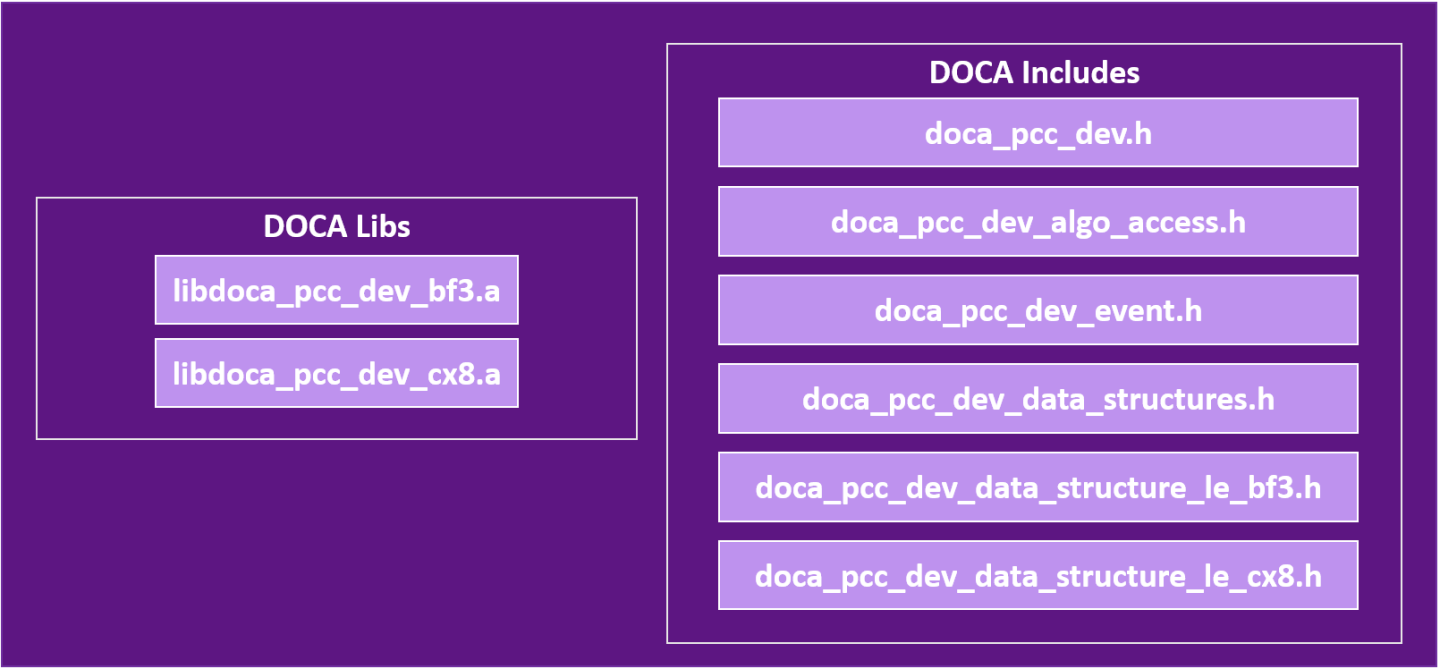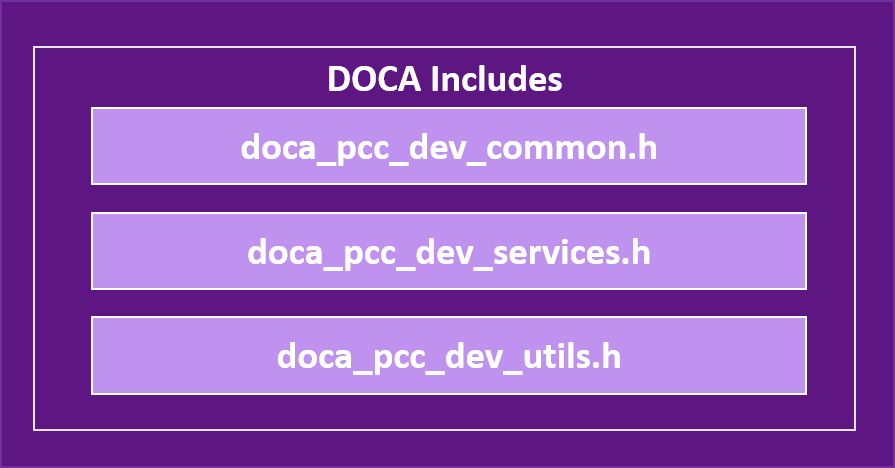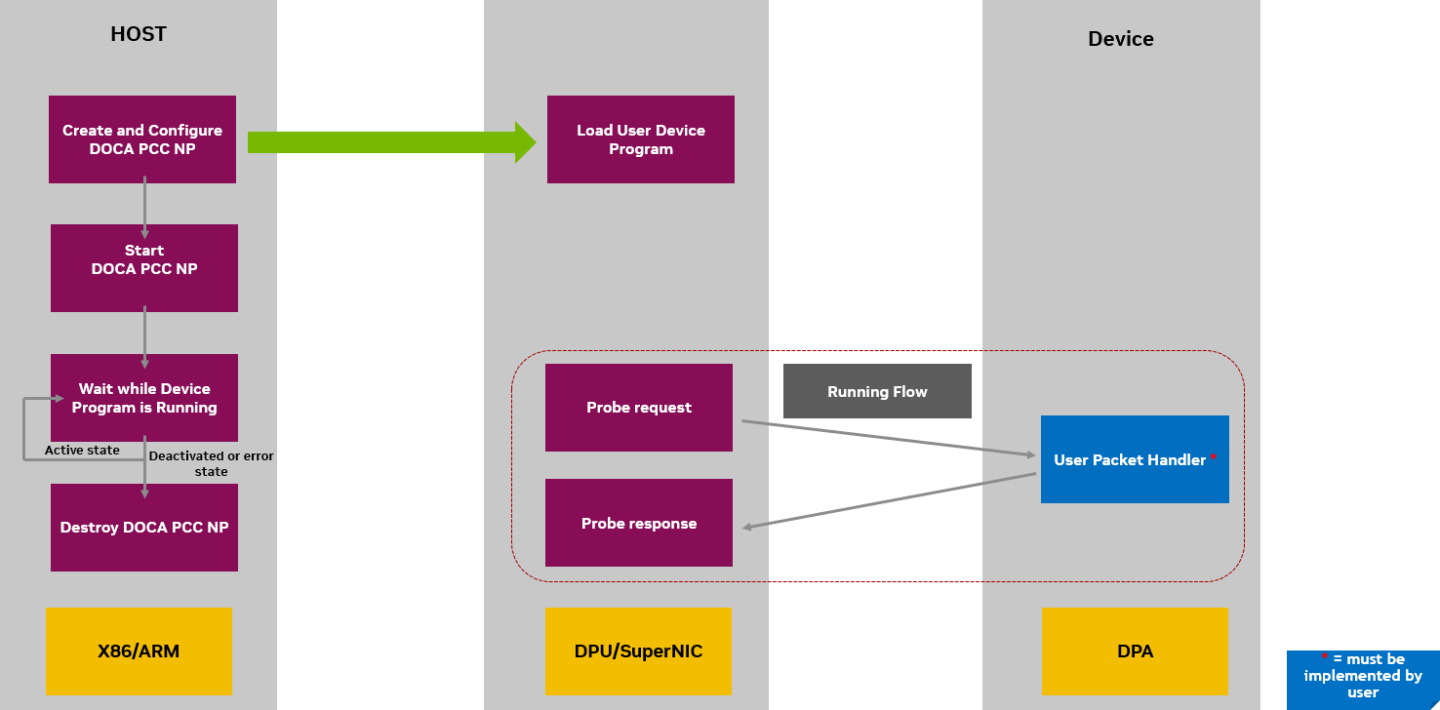DOCA PCC
This guide provides an overview and configuration instructions for the DOCA Programmable Congestion Control (PCC) API.
The quality status of DOCA libraries is listed here.
The DOCA PCC library offers a high-level programming interface that enables users to implement customized congestion control (CC) algorithms. By leveraging the NVIDIA® BlueField®-3 platform hardware acceleration, it facilitates efficient network congestion management while abstracting away hardware complexities.
With the DOCA PCC API, users can:
Configure probe packets for sending and receiving
Retrieve CC events or packets and access their fields
Set flow rate limits to regulate network traffic
Maintain per-flow contexts for individualized management
Initiate and configure CC algorithms tailored to application needs
Process incoming request packets and generate appropriate response packets
This streamlined API allows developers to focus on designing and implementing congestion control logic without worrying about low-level hardware operations.
DOCA PCC-based applications can run on either the host machine or the NVIDIA BlueField-3 Platform (or later) target.
Currently, DOCA PCC is supported only for the ETHERNET link type.
Enabling DOCA PCC
To enable DOCA PCC RP:
On the host/VM, run:
mlxconfig -d <mlx_device> -y s USER_PROGRAMMABLE_CC=
1Perform a graceful shutdown and then power cycle the host.
To enable DOCA PCC NP:
On the host/VM, run:
mlxconfig -d <mlx_device> -y s PCC_INT_EN=
0Perform a graceful shutdown and then power cycle the host.
Configuration Notes
Setting PCC_INT_EN to 1 blocks the creation of DOCA PCC NP context and enables the legacy NP solution. It also only supports DOCA PCC RP context for setting Congestion Control Message After Drop (CCMAD) probe packet format.
For IFA2.0 support, enable both DOCA PCC RP and DOCA PCC NP on all cluster nodes.
The DOCA PCC NP process requires root access.
For BlueField-3 devices in DPU mode, executing the DOCA PCC NP process on an x86 host is not supported.
When running from an x86 host in NIC mode, privileged permissions are required. Check the privilege level using mlxprivhost -d <mlx_device> q.
DPACC Tool
The DPACC tool compiles and links user algorithms and device code with the DOCA PCC device library to create loadable applications. DPACC is included in the DOCA SDK installation package. For more information, refer to NVIDIA DOCA DPACC Compiler documentation.
Changes in 3.1.0
Updated
Starting From July'25 FW version, probe requests destination QP number is 0xF. It is expected that both NP and RP have minimal version of July 2025 FW or newer.
The library requires firmware version 32.38.1000 and higher.
DOCA PCC comprises three main components which are part of the DOCA SDK installation package.
Host Library
The host library offers a unified interface for managing the DOCA PCC context configuration.
As part of the control path, the host library integrates passively within the application, orchestrating congestion control activities without directly handling data transmission.
Host/device library and header files:

Device Libraries
The DOCA PCC context assumes one of two roles:
Reaction point (RP): Monitors network conditions actively, dynamically adjusting data transmission rates to alleviate congestion promptly. RP context is global per NIC.
Device library and header files:

Notification point (NP): Passively receives congestion notifications from external sources, processing them intelligently to facilitate informed decisions within the application. NP context is global per e-switch owner.
Device library and header files:

Both RP and NP device libraries share common headers:

Currently, the device library and the user algorithm are implemented and managed over the BlueField's data-path accelerator (DPA) subsystem.
For more info on DPA, refer to DPA Subsystem.
Development Flow
DOCA enables developers to program the congestion control algorithm into the system using the DOCA PCC library.
The following are the required steps to start programming:
Implement CC algorithms and probe packet handling using the API provided by the device header files.
Implement the user callbacks defined by the library for DataPath:
For RP:
doca_pcc_dev_user_init(),doca_pcc_dev_user_set_algo_params(),doca_pcc_dev_user_algo().For NP:
doca_pcc_dev_np_user_packet_handler()
Use DPACC to build a DPA application (i.e., a host library which contains an embedded device executable). Input for DPACC are the files containing the implementation of the previous steps.
Build host executable using a host compiler. Inputs for the host compiler are the DPA application generated in the previous step and the user application host source files.
In the host executable, create and start a DOCA PCC context which is set with the DPA application containing the device code.

For a more descriptive example, refer to NVIDIA DOCA PCC Application Guide.
System Design
DOCA PCC flow for implementing an RP program:

DOCA PCC flow for implementing an NP program:

For the library API reference, refer to PCC API documentation in the API References.
The following sections provide additional details about the library API.
Host API
The host library API consists of calls to set the PCC context attributes and observe availability of the process.
Selecting and Opening DOCA Device
To perform PCC operations, a device must be selected. To select a device, users may iterate over all DOCA devices using
doca_devinfo_list_create()
and check whether the device supports the desired PCC role either via
doca_devinfo_get_is_pcc_supported()
for RP, or doca_pcc_np_cap_is_supported() for NP.
Setting Up and Starting DOCA PCC Context
After selecting a DOCA device, a PCC context can be created.
As described in the Architecture section, The DOCA PCC library provides APIs to leverage Reaction Points (RP) and Notification Points (NP) to implement programmable congestion control strategies.
Call doca_pcc_create() to create a DOCA PCC RP context, and doca_pcc_np_create() to create a DOCA PCC NP context.
Afterwards, the following attributes must be set for the PCC context:
Context app – the name of the DPA application compiled using DPACC, consisting of the device algorithm and code. This is set using the call
doca_pcc_set_app().Context threads – the affinity of DPA threads to be used to handle CC events. This is set using the call
doca_pcc_set_thread_affinity(). The number of threads to be used must be constrained between the minimum and maximum number of threads allowed to run the PCC process (seedoca_pcc_get_min_num_threads()anddoca_pcc_get_max_num_threads()). The availability and usage of the threads for PCC is dependent on the complexity of the CC algorithm, link rate, and other potential DPA users.NoteUsers can manage DPA threads in the system using EU pre-configuration with the
dpaeumgmttool. For more information, refer to Single Point of Resource Distribution.
After setting up the context attributes, the context can be started using doca_pcc_start(). Starting the context initiates the CC algorithm supplied by the user.
Configuring Probe Packets
The DOCA PCC library provides APIs to configure the probe packet settings to tailor congestion control behaviors according to specific network conditions.
The probe packet serves to probe the network for congestion and gather essential feedback for congestion control algorithms.
The DOCA PCC Library supports the following probe packet types:
CCMAD – Provides information about the network's round-trip time so the algorithm can detect and adapt to congestion proactively
IFA1 – In-band Flow Analyzer 1 packets provide in-band congestion feedback for proactive congestion control
IFA2 – In-band Flow Analyzer 2 packets offer an alternative method for in-band congestion feedback, optimized for specific network environments
Configuring Dedicated Fields for Different Probe Types
The DOCA PCC library provides APIs to configure specific fields in different supported probe packet types.
IFA1 – support to configure probe marker
IFA2 – support to configure gns and hop limit
Configuring Remote NP Handler
To enable Reaction Point contexts to interact with remote Notification Point contexts, the DOCA PCC library provides an API to set the expected remote handler type.
When the DOCA PCC RP process expects CCMAD probe packet responses from a DOCA PCC NP process, it should set it as so using the API doca_pcc_rp_set_ccmad_remote_sw_handler(). If not set, the DOCA PCC RP process expects that no remote DOCA PCC NP process is activated, and that responses are handled by the remote node's hardware.
Note that if using other probe types than CCMAD, probe packet responses are always expected to be generated from a remote DOCA Notification Point process.
Debuggability
The DOCA PCC library provides a set of debugging APIs to allow the user to diagnose and troubleshoot any issues on the device, as well as accessing real-time information from the running application:
doca_pcc_set_dev_coredump_file()– API to set a filename to write crash data and core dump into should a fatal error occur on the device side of the application. The data written into the file would include a memory snapshot at the time of the crash, which would contain information instrumental in pinpointing the cause of a crash (e.g., the program's state, variable values, and the call stack).doca_pcc_set_trace_message()– API to enable tracing on the device side of the application by setting trace message formats that can be printed from the device. The tracer provided by the library is of high-frequency and is designed to not have significant impact on the application's performance. This API can help the user to monitor and gain insight into the behavior of the running device algorithm, identify performance bottlenecks, and diagnose issues, w ithout incurring any notable performance degradation.doca_pcc_set_print_buffer_size()– API to set the buffer size to be printed by the print API provided by the device library.
Device Mailbox
The DOCA PCC library provides a set of APIs for sending and receiving messages through a mailbox. This service allows communication between the host and device :
doca_pcc_set_mailbox()– API to set the mailbox attributes for the process .doca_pcc_mailbox_get_request_buffer()anddoca_pcc_mailbox_get_response_buffer()– API to get the buffers with which the communication will be handled . User can set the request he wants to send to the device, and get a response back.doca_pcc_mailbox_send()– API to send the mailbox request to the device. This is a blocking call which invokes a callback on the devicedoca_pcc_dev_user_mailbox_handle()which user can handle.
High Availability
The DOCA PCC library provides high availability, allowing fast recovery should the running PCC process malfunction. High availability can be achieved by running multiple PCC processes in parallel.
When calling doca_pcc_start(), the library registers the process with the BlueField firmware such that the first PCC process to be registered becomes the ACTIVE PCC process (i.e., actually runs on DPA and handles CC events).
The other processes operate in STANDBY mode. If the ACTIVE process stops processing events or hits an error, the firmware replaces it with one of the standby processes, making it ACTIVE.
The defunct process should call doca_pcc_destroy() to free its resources.
The state of the process may be observed periodically using doca_pcc_get_process_state(). A change in the state of the process returns the call doca_pcc_wait().
The following values describe the state of the PCC process at any point:
typedef enum {
DOCA_PCC_PS_ACTIVE = 0,
/**< The process handles CC events (only one process is active at a given time) */
DOCA_PCC_PS_STANDBY = 1,
/**< The process is in standby mode (another process is already ACTIVE)*/
DOCA_PCC_PS_DEACTIVATED = 2,
/**< The process was deactivated by NIC FW and should be destroyed */
DOCA_PCC_PS_ERROR = 3,
/**< The process is in error state and should be destroyed */
} doca_pcc_process_state_t;
Device API
The device library API consists of calls to setup the CC algorithm to handle CC events arriving on hardware.
Counter Sampling
The device libraries APIs provide an API to sample the NIC bytes counters. These counters help monitor the amount of data transmitted and received through the NIC.
The user can prepare the list of counters to read using doca_pcc_dev_nic_counters_config() and sample the new counters values with the call doca_pcc_dev_nic_counters_sample().
It is recommended to configure the counters in the user callback doca_pcc_dev_user_port_info_changed()
as it indicates the port state to sample counters from.
Algorithm Access
The Reaction Point (RP) device library API provides a set of functions to initiate and identify the different CC algorithms.
The DOCA PCC library is designed to support more than one PCC algorithm.
The library comes with a default algorithm which can be used fully or partially by the user using
doca_pcc_dev_default_internal_algo()
, alongside other CC algorithms
supplied by the user
. This can be useful for fast comparative runs between the different algorithms. Each algorithm can run on a different device port using
doca_pcc_dev_init_algo_slot()
.
The algorithm can supply its own identifier, initiate its parameter (using
doca_pcc_dev_algo_init_param()), counter (using doca_pcc_dev_algo_init_counter()), and metadata base (using doca_pcc_dev_algo_init_metadata()).
Events
The RP device library API provides a set of optimized CC event access functions. These functions serve as helpers to build the CC algorithm and to provide runtime data to analyze and inspect CC events arriving on hardware.
Utilities
The device library APIs provide a set of optimized utility macros that are set to support programming the CC algorithm. Such utilities are composed of fixed-point operations, memory space fences, and more.
User Callbacks
The device libraries API consists of specific user callbacks used by the library to initiate and run the CC algorithm and handle input and output packets. These callbacks must be implemented by the user and, to be part of the DPA application, compiled by DPACC to provide to the DOCA PCC context.
The set of callbacks to be implemented for RP:
doca_pcc_dev_user_init()– called on PCC process load and should initialize the data of all user algorithmsdoca_pcc_dev_user_algo()– entry point to the user algorithm handling codedoca_pcc_dev_user_set_algo_params()– called when the parameter change is set externally
The set of callbacks to be implemented for NP:
doca_pcc_dev_np_user_packet_handler()– called on probe packets arrival